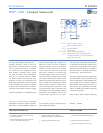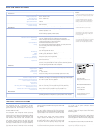
M2D-Sub specifications
1. The low-frequency power response of
the system will increase according to the
length of the array.
2. Recommended maximum operating
frequency range. Response depends on
loading conditions and room acoustics.
3. Free field, measured with 1/3 octave
frequency resolution at 4 meters.
4. Measured with music at 1 meter.
5.
Power handling is measured under AES
standard conditions: transducer driven
continuously for twohours with a band-
limited noise signal having a 6 dB peak-
to-average ratio.
6. Amplifier wattage rating is based on
the maximum unclipped burst sine-wave
rms voltage that theamplifier will produce
into the nominal load impedance. Both
channels: 67 V rms (95 V pk) into 4 ohms.
architect specifications
meyer sound laboratories inc.
2832 San Pablo Avenue
Berkeley, CA 94702
T: +1 510 486.1166
F: +1 510 486.8356
techsupport@meyersound.com
www.meyersound.com
M2D-SUB -
04.114.030.01
Copyright © 2004
Meyer Sound Laboratories Inc.
All rights reserved
Operating Frequency Range
2
Frequency Response
3
Phase Response
Maximum Peak SPL
4
Signal to Noise Ratio
Horizontal Coverage
Vertical Coverage
Low Frequency
Type
Maximum Common Mode Range
Connectors
Input Impedance
Wiring
DC Blocking
CMRR
RF Filter
TIM Filter
Nominal Input Sens
itivity
Input Level
Type
Output Power
6
THD, IM, TIM
Load Capacity
Cooling
Connector
Automatic Voltage Selection
Safety Agency Rated Operating Range
Turn-on and Turn-off Points
Current Draw:
Idle Current
Max Long-Term Continuous Current (>10 sec)
Burst Current (<1 sec)
Ultimate Short-Term Peak Current Draw
Inrush Current
28 Hz - 160 Hz
30 Hz - 140 Hz ±4 dB
40 Hz - 100 Hz ±45°
138 dB
>110 dB
360° Horizontal
Varies, depending on array length and configuration
Two 15" cone drivers with neodymium magnets
Nominal impedance: 4
Ω
Voice coil size: 4"
Power-handling capability: 1200 W (AES)
5
Differential, electronically balanced
±15 V DC, clamped to earth for voltage transient protection
Female XLR input with male XLR loop outputor
VEAM all-in-one
connector (integrates AC, audio and network)
10 k
Ω
differential between pins 2 and 3
Pin 1: Chassis/earth through 220 k
Ω
, 1000 pF, 15 V clamp network to
provide virtual ground lift at audiofrequencies
Pin 2: Signal +
Pin 3: Signal -
Case: Earth ground and chassis
None on input; DC blocked through signal processing
>50 dB, typically 80 dB (50 Hz - 500 Hz)
Common mode: 425 kHz; Differential mode: 142 kHz
Integral to signal processing (<80 kHz)
0 dBV (1 V rms, 1.4 V pk) continuous is typically the onset of limiting for
pink noise and music
Audio source must be capable of producing a minimum of 20 dBV
(10 V rms, 14 V pk) into 600
Ω
inorder to produce maximum peak SPL
over the operating bandwidth of the loudspeaker
Two channel complementary MOSFET output stages (class AB/H)
2250 W
<.02 %
4
Ω
each channel
Forced air cooling, two fans (one ultrahigh-speed reserve fan)
PowerCon or VEAM
Automatic, two ranges, each with high-low voltage tap (uninterrupted)
95 - 125 V AC; 208 - 235 V AC; 50/60 Hz
85 - 134 V AC; 165 - 264 V AC; 50/60 Hz
0.64 A rms (115 V AC); 0.32 A rms (230 V AC); 0.85 A rms (100 V AC)
8.8 A
rms
(115 V AC); 4.4 A
rms
(230 V AC); 10 A
rms (
100 V AC)
19 A rms (115 V AC); 9.5 A rms (230 V AC); 22 A rms (100 V AC)
39 A pk (115 V AC); 20 A pk (230 V AC); 45 A pk (100 V AC)
7 A pk (115 V AC and 230 V AC); 10 A pk (100 V AC)
Equipped for two conductor twisted-pair network, reporting all
operating parameters ofamplifiers to system operator’s host computer.
Acoustical
1
Coverage
Coverage
Transducers
Audio Input
Amplifiers
AC Power
RMS Network
The loudspeaker shall be a self-powered, sub-bass
system which may be deployed as either a flown or a
ground-stacked unit. The transducers shall consist of
two 15-inch cone drivers (4-inch voice coil) each rated
to handle 1200 AES* watts.
The loudspeaker shall incorporate internal processing
electronics and a two-channel amplifier. Each amplifier
channel shall be class AB/H with complementary MOSFET
output stages. Burst capability shall be 2250 watts total
with nominal 4-ohm resistive load. Distortion (THD,
IM, TIM) shall not exceed 0.02%. Protection circuits
shall include TruPower limiting. The audio input shall
be electronically balanced with a 10 kOhm impedance
and accept a nominal 0 dBV (1 V rms) signal (20 dBV to
produce maximum SPL). Connectors shall be XLR (A-3)
type male and female or VEAM all-in-one. RF filtering
Notes:
shall be provided, and CMRR shall be greater than 50 dB
(50 - 500 Hz).
Performance specifications for a typical production unit
shall be as follows, measured at 1/3 octave resolution:
Operating frequency range shall be 28 Hz to 160 Hz. Phase
response shall be ±45° from 40 Hz to 100 Hz. Maximum
SPL shall be 138 dB at 1 meter.
The internal power supply shall perform automatic
voltage selection, EMI filtering, soft current turn-on
and surge suppression. Powering requirements shall
be nominal 100 V, 110 V or 230 V AC line current at 50
Hz or 60 Hz. UL and CE operating voltage ranges shall
be 95 to 125 V AC and 208 to 235 V AC.
Current draw
during burst
shall be 19 A at 115 V AC and 9.5 A at 230 V
AC. Current inrush during soft turn-on shall not exceed
7 A at 115 V AC. AC power connectors shall be
PowerCon or VEAM.
The loudspeaker system shall incorporate the
electronics module for Meyer Sound’s RMS remote
monitoring system.
All loudspeaker components shall be mounted in a
multi-ply hardwood enclosure with a black textured
finish. Dimensions shall be 39.00" wide x 24.00" high x
17.50" deep (991 mm x 612 mm x 445 mm). Weight shall
be 173 lbs (78.47 kg).
The loudspeaker shall be the Meyer Sound M2D-Sub.
*Driven continuously for two hours with band-limited noise
signal having a 6 dB peak-average ratio.




